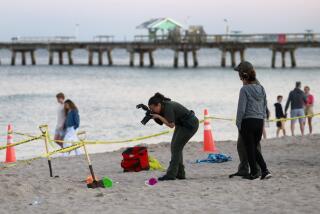Deadly Play : Deaths, Injuries Stir Concern About Safety of Kids’ Playground Equipment
- Share via
Tina Shubin stepped onto the patio of her Fullerton home at dusk on a warm spring night a year ago and saw her son Matthew, 3, on the back-yard swing set.
“I called his name. I said, ‘C’mon, sweetie,’ ” she recalled. “He looked like he could be holding on to the bar on top. He did not come. As I got closer, I realized he was suspended by his sweater. I screamed.”
Her husband, Bill Shubin, dropped the kitchen phone and ran to the yard. When he arrived, he could see his son was not moving. He pulled him down and tried to resuscitate him.
Slipped on Top Beam
Meanwhile, Tina Shubin called paramedics. But they could not revive Matthew, who had strangled after he apparently climbed up an attached slide to the top beam of the swing set, then slipped, his sweater collar catching on a protruding bolt or an S-hook holding the swing chain.
The youngster with the curly golden hair and blue-green eyes was not the only child in Southern California to die recently on playground equipment.
On March 23, 1988, two weeks before Matthew’s death, blond, blue-eyed Cari Outzen, 3, of Pasadena, strangled when her neck caught on the crossbar on the side of a swing at a Whittier day-care center.
About four months later, on Independence Day, Plese Williams, 4, of Long Beach, was found with a shoelace under his chin atop a slide at a Santa Ana apartment he was visiting. The long lace was tied to a post on climbing equipment next to the slide; the boy, wearing a swim suit and thongs, had strangled.
Nationwide last year, at least 10 to 15 children died and 192,000 youngsters age 15 or younger were injured in playground equipment-related accidents, the U.S. Consumer Product Safety Commission in Washington reports. The agency said its figures also may not cover the full toll because they represent unsystematic accounts of deaths and injuries reported to hospital emergency rooms.
But concerned with the figures--as well as with the growing numbers of lawsuits produced by problems with aging playground equipment--many states, local governments and private groups are upgrading standards or recommending safety guidelines exceeding those issued for manufacturers by the safety commission in 1981.
Regulations Due to Be Adopted
In Colorado, for example, the state Board of Health appears ready to adopt widely expanded regulations on playground equipment. The guidelines urge that protective surfaces be installed under equipment and that equipment be free of splinters, sharp edges and pinch points.
In Philadelphia, the American Society for Testing and Materials is developing guidelines for playground equipment for children under 5, an area not covered by safety commission rules.
A recent study by the American Assn. for Leisure and Recreation in Reston, Va., also goes further than federal guidelines, recommending that no playground equipment be more than 8 feet high, primarily to prevent injuries from falls.
PLAE Inc., a Berkeley nonprofit group that creates programs for children, also wants to expand on the safety commission presentations. It has recommended guidelines for equipment for children with disabilities; it urges that at least 12 inches of loose, resilient surface such as sand be installed under equipment.
Los Angeles ‘Doctor’
And in Los Angeles, a much-heralded program called the “Playground Equipment Doctor” has transformed six vans into machine shops on wheels and is sending them to city parks each month to check equipment.
Although many educators, public officials and manufacturers find the federal safety commission guidelines inadequate, they filled a void when they were issued eight years ago.
According to federal regulators, falls account for 70% of all injuries related to playground equipment; nearly half of injuries resulting from falls are to the head. Hard surfaces including asphalt and concrete provide inadequate protection.
The guidelines also recommend equipment that reduces children’s chances of getting trapped, tangled, cut or pinched by play equipment. They warn against openings that can trap a child’s head or body and handrails or other barriers that can snag their clothing.
Legal Implications
Experts say courts play close attention to the guidelines and that a playground equipment manufacturer who refuses to follow them will lose if sued.
Still, the guidelines lack the force of law--a reality related to the complexities of modern litigation and playground manufacturing, explained John D. Preston of the safety commission, who said: “Suppose I build a climbing frame and offer a sliding board as an option. Do I call it a slide or a climbing machine, and what standards should I comply with? Playgrounds tend to have more multiuse pieces than they did 20 to 30 years ago. You can’t write regulations for a piece of equipment because it may be part of a different piece.”
Even simply as recommendations, though, the federal safety guidelines go largely unmet on American playgrounds.
Jay Beckwith, a playground designer from Forestville, near Santa Rosa, Calif., said a recent study of the nation’s 64,000 public elementary schools showed that “less than 5% meet federal guidelines.”
Schools Don’t Meet Standards
“We found that in terms of the parks and schools, the playgrounds are pretty hazardous,” Beckwith said of results of a study by the American Assn. for Health, Physical Education, Recreation and Dance in Reston, Va. “The schools, in particular, fail to reach the minimum standards.”
He said parks do a better job than schools on safety because they use better surfaces. “They put in sand, and schools don’t do that very often.”
Seymour M. Gold, environmental planning professor at UC Davis, agreed, saying: “Many of the playgrounds represent a subtle form of child abuse. . . . Most of those playgrounds consist of equipment purchased and installed (in the 1950s and 1960s) long before the (safety commission) guidelines were published.”
Equipment manufacturers argue that more than design is responsible for playground injuries.
‘No Blatant Disregard’
“Most manufacturers do a very good job in regard to safety,” said Ralph Vatterott, director of engineering for Iron Mountain Forge of Farmington, Mo., one of the nation’s largest playground equipment manufacturers.
He said he sees “no blatant disregard from a design or from a safety aspect. Occasionally, somebody gets hurt and you say, ‘Son of a gun. We never thought someone would do that.’ A lot of people think a playground is there just to occupy a kid’s time. But we develop it to enhance a child’s psycho-motor skills and to challenge the gross motor abilities. . . .
“It’s also designed to cover a wide age range from 2 to 12. Recently, somebody mentioned that an 18-month-old child could fall through a space on one of our decks. Our response was, ‘Yes, but if we design everything so that it’s safe for an 18-month-old child, you’ll never find a 9- to 12-year-old on any playground equipment.’
“We put a safety rail on the deck (of some equipment) so the child can’t fall off. I was in one park and saw a child standing on a rail. Do you (compensate by making) no play events that are supported off the ground? How do you cover the incidents where the equipment is not being used according to design?”
City Parks Well Done
Although many playground accidents occur, experts said Los Angeles city parks and schools are comparatively safe.
“The city parks are far and away better than the national standard. They are incredibly well done,” said Beckwith, who has written four books on playground design.
Richard Klink, landscape architect for the City Recreation and Parks Department, said the parks’ reputation results from the “Playground Equipment Doctor” program.
Custom-made vans containing a tool shop and a work bench visit each of the city’s 300 parks and 180 play areas carrying all the nuts, bolts and bearings needed to fix any piece of equipment and enough tools to put any broken equipment out of service. Two specially trained repair people in each van inspect each piece of equipment in the yard for problems.
Emphasis on Safety
“If you invite someone to use your play area, it had better be safe,” Klink said. “Once kids find out our equipment is there, they’re excited.”
The program, which started in 1987, emphasizes the use of resilient surfaces under equipment.
Such surfaces also are partly responsible for the reputation of Los Angeles Unified School District playgrounds. Margaret Scholl, the school’s maintenance director, said the district requires interlocking rubber mats under all playground equipment.
“Los Angeles gives us the best example we have on the difference that resilient materials can make on playgrounds,” said Joe Frost, Parker Centennial Professor in early childhood education at the University of Texas. Frost said that in the 20 years before 1951, there had been 11 playground deaths in Los Angeles, largely due to children falling on hard surfaces.
Injuries Down Sharply
But “in the 10 years following the purchase and installation of rubber surfaces in 1955, there were no fatalities,” he said. “In the same period, there was a reduced accident rate with regard to fractures and concussions from 1.25 per school in 1955 to .47 per school in 1965.”
Back-yard equipment may be less safe than park and school playgrounds because “people are ignorant of even the most minimal (safety) standards,” Beckwith said.
The Shubins, however, said they took great care in seeking what they thought would be safe equipment for their child.
“Matthew was a live wire. We knew we had to accommodate his curiosity,” Tina Shubin said. “We have child guards on every cabinet in the house. We have double locks on every door. He learned when he was less than a year old to open the dead bolt, so we had to put in a second lock 5 1/2 feet high. We got double gates in the back so there was no way he could get out. There are no sharp edges inside or outside the house.
Shopped for a Good Set
“The ironic thing about the swing set is that we shopped and we wanted to make sure we got something beefy that would not fall apart. We bought a brand that people would know. Now that it’s happened to us I can look and say: That swing is unsafe. Those protruding bolts are awful. But as parents we did not realize that we had to look at the swing that closely. You never imagine that a simple S hook or a protruding bolt could be a danger.”
The Shubins are emerging from their grief and beginning efforts to create safer playgrounds a year after they lost their son.
“For the first year, you are just working through your grief and trying to restructure your lives,” Tina Shubin said in a recent interview in her family room.
She watched her other children, Patrick, 8, and Christiana, 11 months, playing in the back yard. A family portrait with Matthew wearing a suit hung on a wall opposite her.
A Cemetery Ritual
She still leaves her immaculate four-bedroom Coyote Hills home each week to visit the Whittier cemetery where Matthew is buried.
“I go not because I believe that is where Matthew is, but because being a mom is something that’s real hard to stop being,” she said. “I do it for me because I need to keep doing it for him.”
She leaves fresh flowers, rakes leaves and trims the lawn to ensure “his little square of grass is perfectly manicured.”
Meanwhile, the Shubins are considering a lawsuit against the equipment manufacturer, whom they declined to name. They have taken the swing set apart, and in the spot where it stood, they have planted three trees for Matthew and their other children.
A Slender Sapling
Matthew was nicknamed Sugar Plum by his mother, so his tree, the middle one, is a plum tree. It is a tall, slender, graceful sapling, already twice the size of the other two.
“You always think this is going to happen to someone else,” said Bill Shubin, a soft-spoken elevator repairman. “Someone will read this article and say that cannot happen to us. We want to get the word out that if it can happen to us, and we’re very careful, it can happen to anybody.
“We as consumers have to rethink our position. For so long, everyone thought that the government was looking out for us, or that if the product has a good name, it has to be safe. It seems to me that manufacturers should be held more accountable.”
Gold, the UC Davis environmental planning professor, observed: “This is the age of the child. Parents should not take the safety of the playground for granted. They should inquire if it does meet current standards. And if it doesn’t, they should ask why it cannot be replaced.”
PLAYGROUND INJURIES Estimated number of injuries in the U.S. related to playground equipment.
1983: 183,000
1984: 195,000
1985: 197,000
1986: 191,000
1987: 185,000
1988: 192,000
Source: U.S. Consumer Products Safety Commission
More to Read
Sign up for Essential California
The most important California stories and recommendations in your inbox every morning.
You may occasionally receive promotional content from the Los Angeles Times.










